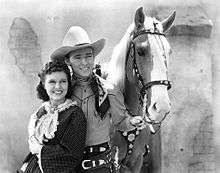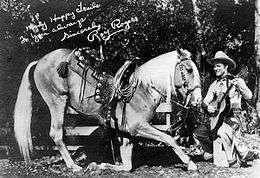Trigger (horse)
 Roy Rogers and Lynne Roberts with Trigger | |
| Breed | Grade horse |
|---|---|
| Discipline | Movie horse |
| Sex | Stallion |
| Foaled | July 4, 1934 |
| Died | July 3, 1965 |
| Country | United States |
| Color | Palomino |
| Owner | Roy Rogers |
Trigger (originally named Golden Cloud, July 4, 1934 – July 3, 1965) was a 15.3 hands (63 inches, 160 cm) palomino horse made famous in American Western films with his owner and rider, cowboy star Roy Rogers.
Pedigree
Trigger was born in San Diego, California. Though often mistaken for a Tennessee Walking Horse, his sire was a Thoroughbred and his dam a grade (unregistered) mare who, like Trigger, was a palomino. Movie director William Witney, who directed Roy and Trigger in many of their movies, claimed a slightly different lineage, that his sire was a "registered" Palomino stallion, though no known Palomino registry existed at the time of Trigger's birth, and his dam was by a Thoroughbred and out of a "cold-blood" mare.[1] Horses other than Golden Cloud also portrayed "Trigger" over the years, none of which was related to Golden Cloud, the two most prominent of which were palominos known as "Little Trigger" and "Trigger Jr." (who was a Tennessee Walking Horse listed as "Allen's Gold Zephyr" in the Tennessee Walking Horse registry).[2] Though Trigger remained a stallion his entire life, he was never bred and has no descendants. On the other hand, Roy Rogers used "Trigger Jr."/"Allen's Golden Zephyr" at stud for many years, and the horse named "Triggerson" that actor Val Kilmer led on stage as a tribute to Rogers and his cowboy peers during the Academy Awards show in March 1999 was reportedly a grandson of "Trigger Jr."[3]
Film career

Golden Cloud made an early appearance as the mount of Maid Marian, played by Olivia de Havilland in The Adventures of Robin Hood (1938). A short while later, when Roy Rogers was preparing to make his first movie in a starring role, he was offered a choice of five rented "movie" horses to ride and chose Golden Cloud. Rogers bought him eventually in 1943 and renamed him Trigger for his quickness of both foot and mind. Trigger learned 150 trick cues and could walk 50 feet (15 meters) on his hind legs (according to sources close to Roy Rogers). They were said to have run out of places to cue Trigger. Trigger became such a ham that as soon as he heard applause he would start bowing and ruin that trick. He could sit in a chair, sign his name "X" with a pencil, lay down for a nap and cover himself with a blanket. Roger's most carefully guarded trade secret was to get Trigger housebroken. "Spending as much time as he does in hotels, theaters, and hospitals, this ability comes in might handy and it's conceded by most trainers to be Trigger's greatest accomplishment." —Glenn Randall, wrangler with Hudkins Stables.[4]
Trigger was ridden by Rogers in many of his motion pictures, becoming much loved by the youthful audience that saw him on film and in Rogers' 1950s television series with his wife Dale Evans, who rode her trusty buckskin Quarter Horse Buttermilk.
Trigger became the most famous horse in film entertainment, even having his own Dell comic book recounting his exploits.
Roy Rogers made many personal appearances with Trigger in tow. More than once Rogers escorted Trigger up 3-4 flights of stairs at hospitals to visit with sick children, according to his autobiography "Happy Trails."
Death and legacy

After the original Trigger (Golden Cloud) died in 1965 at Rogers' Hidden Hills, California ranch, Rogers arranged for Everett Wilkensen of Bischoff's Taxidermy in Los Angeles, CA (now Bischoff's Taxidermy and Animal FX in Burbank, CA) to preserve/mount the horse.[5] The hide was professionally stretched over a foam likeness of Trigger, and the resulting mount was put on display in the Roy Rogers and Dale Evans Museum when it opened in Apple Valley, California in 1967. The mount was later moved with the museum to first Victorville, California in 1976, and then to Branson, Missouri in 2003.
At some point, a 24-foot (7 meters) replica of a rearing Trigger was produced to sit atop the Roy Rogers Museum in Victorville. The 1300-pound (600 kg) replica could be seen from the freeway and served as a landmark until the museum closed and moved to Branson. When the fiberglass replica of Trigger was being made, Rogers was approached by the owners of the Denver Broncos. Rogers allowed another statue to be made and then broke the mold. "Bucky the Bronco", Trigger's twin, stands above the south scoreboard of the Denver Broncos stadium.[6]
After the closing of the Victorville museum in 2009, its contents were placed at public auction on July 14–15, 2010, at Christie's auction house in New York City.[7] Trigger's preserved taxidermy remains sold for $266,500 to television channel RFD-TV, which plans to start a Western museum.[8] Bob Tinsley, a Victorville developer who had built Roy Rogers' home in nearby Apple Valley, bought the fiberglass replica in April 2010. Tinsley's plan is to make the statue a part of historic Apple Valley Village. He explained, "I just couldn't see letting him go anywhere else."[9]
Selected filmography
- "The Adventures of Robin Hood" (1938)
- San Fernando Valley (1944)
- Lake Placid Serenade (1944)
- Don't Fence Me In (1945)
- Along the Navajo Trail (1945)
- My Pal Trigger (1946)
- Under California Stars (1948)
- Melody Time (1948)
- The Golden Stallion (1949)
- "Son of Paleface" (1952)
See also
References
- Citations
- ↑ Witney, William. "Trigger Remembered".
- ↑ "More Than One Trigger?". RoyRogersWorld.com. Retrieved May 21, 2013.
- ↑ Dortch, Joel "Dutch". "Trigger: "The Smartest Horse in the Movies"". Roy Rogers Estate. Retrieved May 21, 2013.
- ↑ Miller Davis, Elise (1955). The Answer is God (1st ed.). New York, USA: McGraw-Hill Book Co. p. 50, 42. LCCN 55009539.
- ↑ "Trigger's taxidermist now busy with TV werewolves". The Seattle Times Company. Retrieved May 21, 2013.
- ↑ "Guide to Sports Authority Field at Mile High". cbslocal.com. Retrieved July 10, 2014.
- ↑ "Roy Rogers Auction Features Horse Trigger's Remains". TheHuffingtonPost.com. July 9, 2010. Retrieved May 21, 2013.
- ↑ Dou, Eva (July 14, 2010). "Roy Rogers' stuffed horse Trigger sold at auction". USA Today. Retrieved July 16, 2010.
- ↑ Edwards, Brooke. "Trigger returns". Daily Press, May 6, 2010.
- Bibliography
- Pando, Leo (2007). An Illustrated History of Trigger, The Lives and Legend of Roy Rogers' Palomino. McFarland Publishing. ISBN 978-0-7864-6111-0.
External links
- Roy Rogers and Dale Evans Museum
- Trigger at the Internet Movie Database
- Trigger at Find a Grave
- Auction information at Christie's (July 14–15, 2010)
